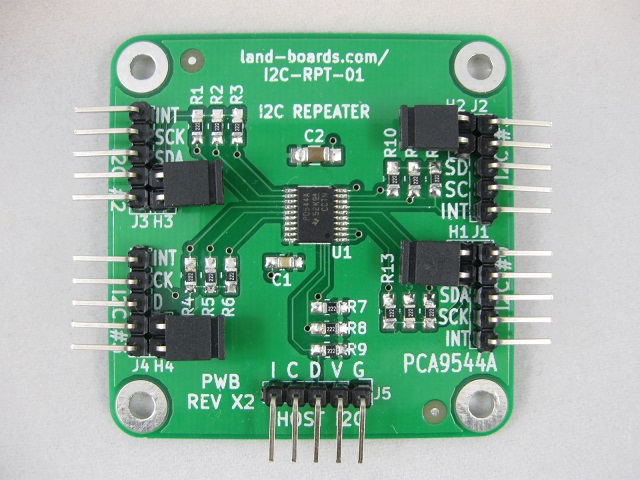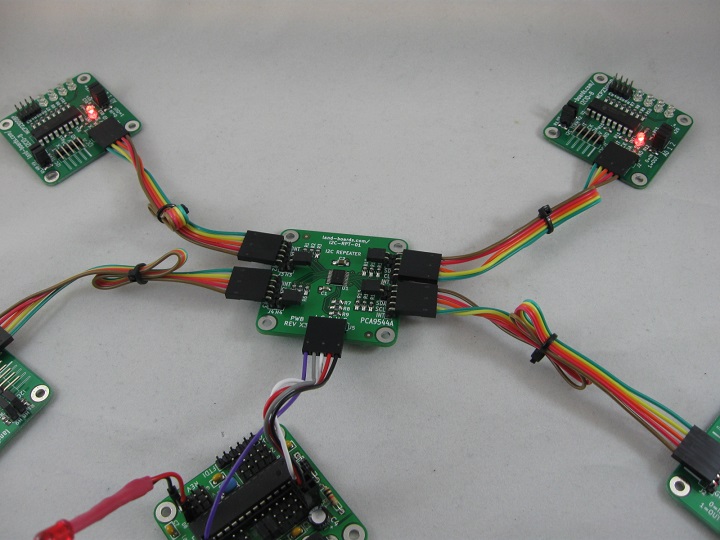Difference between revisions of "I2C-RPT"
Jump to navigation
Jump to search
Blwikiadmin (talk | contribs) |
Blwikiadmin (talk | contribs) |
||
| Line 36: | Line 36: | ||
=== Test Station Hardware === | === Test Station Hardware === | ||
| + | * Unit Under Test (UUT) | ||
* [[Arduino Based Test Station]] | * [[Arduino Based Test Station]] | ||
* Connects directly to I2C port (J7) on the [[BLACK-PILL-HUB]] | * Connects directly to I2C port (J7) on the [[BLACK-PILL-HUB]] | ||
| Line 41: | Line 42: | ||
** Built in I2C mux on [[BLACK-PILL-HUB]] is set to offset=0x1 so it does not conflict | ** Built in I2C mux on [[BLACK-PILL-HUB]] is set to offset=0x1 so it does not conflict | ||
** Uses 4x of [[I2CIO-8]] cards | ** Uses 4x of [[I2CIO-8]] cards | ||
| + | |||
| + | [[File:I2C_RPT_Test_I6075_720px.jpg]] | ||
| + | |||
| + | == Test Station Software === | ||
| + | |||
* [https://github.com/land-boards/lb-Arduino-Code/tree/master/LBCards/ODAS/ODASTESTER ODAS Tester Github Repo] | * [https://github.com/land-boards/lb-Arduino-Code/tree/master/LBCards/ODAS/ODASTESTER ODAS Tester Github Repo] | ||
| − | + | === Test Procedure === | |
| + | |||
| + | * Connect I2C | ||
== Assembly Sheet == | == Assembly Sheet == | ||
* [[I2C-RPT-01 Assembly Sheet]] | * [[I2C-RPT-01 Assembly Sheet]] | ||
Revision as of 23:06, 31 March 2022
Contents
Features
- I2C Hub / Repeater / Replicator / Multiplexer / De-multiplexer
- Four I2C Ports
- Host port Controlled via I2C
- PCA9544A IC Multiple vendors
- 3.3V or 5V host operation
- 3.3V or 5V slave ports operation
- Voltage translation between the ports
- Example: A Raspberry PI which runs 3.3V can control an I2C device which runs at 5V
- Interrupt line on each channel and host
- 100KHz/400KHz operation
- On-board termination resistors
- 49x49mm form factor
- 4 solid 4-40 mounting holes
- Arduino driver and example code
- Raspberry Pi example code
Drivers/Example Code
- GitHub Repo - Arduino Driver code
- Github Repo - Example code
Schematic
Testing
Test Station Hardware
- Unit Under Test (UUT)
- Arduino Based Test Station
- Connects directly to I2C port (J7) on the BLACK-PILL-HUB
- I2C address offset = 0x0
- Built in I2C mux on BLACK-PILL-HUB is set to offset=0x1 so it does not conflict
- Uses 4x of I2CIO-8 cards
Test Station Software =
Test Procedure
- Connect I2C


